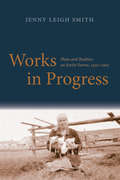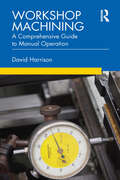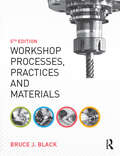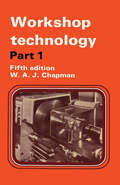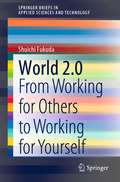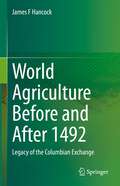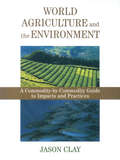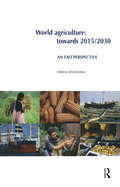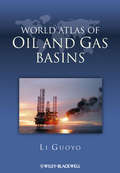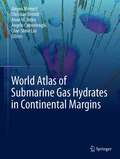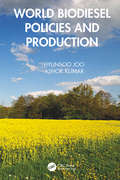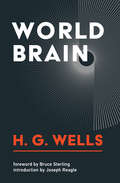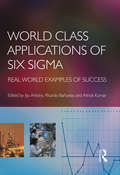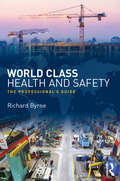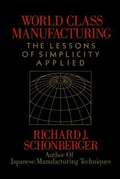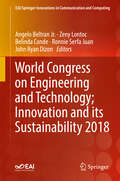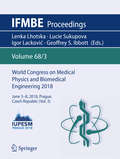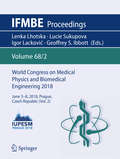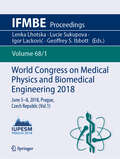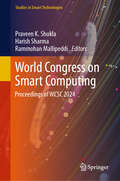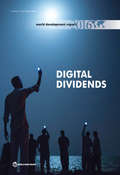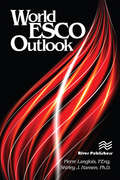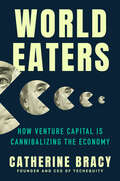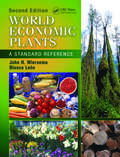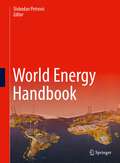- Table View
- List View
Works in Progress
by Jenny Leigh SmithThis book is the first to investigate the gap between the plans and the reality of the Soviet Union’s mid-twentieth-century project to industrialize and modernize its agricultural system. Historians agree that the project failed badly: agriculture was inefficient, unpredictable, and environmentally devastating for the entire Soviet period. Yet assigning the blame exclusively to Soviet planners would be off the mark. The real story is much more complicated and interesting, Jenny Leigh Smith reveals in this deeply researched book. Using case studies from five Soviet regions, she acknowledges hubris and shortsightedness where it occurred but also gives fair consideration to the difficulties encountered and the successes#151;however modest#151;that were achieved.
Workshop Machining: A Comprehensive Guide to Manual Operation
by David HarrisonWorkshop Machining is a comprehensive textbook that explains the fundamental principles of manually operating machinery to form shapes in a variety of materials. It bridges the gap between people who have traditional toolmaking skills and those who have been trained in programming and operation of CNC machines in a focused production environment, rather than general machine shop. Using a subject-based approach, David Harrison intuitively guides readers and supplies practical skills. The chapters cover everything from the basic machine controls to advanced cutting operations using a wide range of tooling and work-holding devices. Theory and practice are shown via a mixture of diagrams, text and illustrated worked examples, as well as through exercises. The book is ideal for students and lecturing staff who participate in, or lead, practical machining sessions, and for those who wish to further develop their machining skills. It also serves as an excellent reference to understand the principles and limitations of producing shapes with cutters that move in a limited combination of linear and radial paths.
Workshop Processes, Practices and Materials, 5th ed
by Bruce J. BlackWorkshop Processes, Practices and Materials is an ideal introduction for entry level engineers and workshop technicians, as well as engineering university students with little or no practical experience. With detailed illustrations throughout and simple, clear language, this is a practical introduction to what can be a very complex subject. It has been significantly updated and revised to include new material on current Health and Safety legislation, gauging and digital measuring instruments, as well as modern measuring techniques such as laser scan micrometer, co-ordinate and visual measuring systems. A new chapter on an introduction to CNC milling and turning has been added. This book covers all standard workshop topics, including safe practices, measuring equipment, hand and machine tools, metal and plastics materials, joining methods including welding, presswork, primary forming, casting and moving loads, making it an indispensable handbook for use both in class and the workshop. Its broad coverage makes it a useful reference book for many different courses worldwide. Health and Safety chapter covers current best practice and has been checked by a certified health and safety examiner. Addition of modern measuring techniques using laser scan micrometer, co-ordinate and visual measuring systems. Addition of an introduction to CNC milling and turning.
Workshop Technology Part 1
by W. ChapmanFirst published in 1972. Routledge is an imprint of Taylor & Francis, an informa company. Dr Chapman's books on workshop technology and calculations have long had an international reputation in workshops and colleges. In their latest editions they now all use SI units throughout. Changes have been made where necessary to take account of developments in practice and equipment, but on the whole the original character and style of the books have been retained. It is the method of instrction which Dr Chapman has combined with his unique style that has proved so successful in the training of workshop engineers all over the world.
World 2.0: From Working for Others to Working for Yourself (SpringerBriefs in Applied Sciences and Technology)
by Shuichi FukudaThis book explores on how the Internet of Things (IoT) will change society by bringing living and non-living things together. The IoT is currently attracting considerable attention, but most of the discussions focus on engineering aspects alone. The IoT, however, is not an extension of traditional engineering, where humans and machines are separated. Instead it connects humans and machines, enabling them to work together as a team: the IoT Connected Society.In traditional engineering, our knowledge and experience of physical and non-living things plays a key role, but such knowledge and experience alone are not enough. We need to introduce life science approaches and integrate them into physical science to really develop the IoT connected society.In addition, the Internet is not only a tool for delivering messages: it is a broader communication tool. In the IoT connected society, living things and non-living things communicate in complex ways. Machines 1. Introduction2. Emerging Industrial Revolution3. IoT: What makes it different from the past revolutions4. World is changing5. Engineering: How It was developed so far6. Humans: Their characteristics7. Value is changing8. Adaptive team organization and management9. Integration of Physical Science and Life Science10. Summary can provide humans with a improved situational awareness and advice, and together they can communicate to develop a better, happier society. Thus, this book makes the case that to make the IoT connected society a reality, we need to integrate the physical and life sciences and develop a new science for the next generation of engineering.
World Agriculture Before and After 1492: Legacy of the Columbian Exchange
by James F HancockThe year 2022 is the 50th anniversary of Alfred Crosby’s celebrated book - The Columbian Exchange: Biological and Cultural Consequences of 1492. In the book, Crosby was the first to discuss the impact that the Spanish and Portuguese colonial period had on world agriculture and human culture. How the crops of the world became homogenized, and how an indigenous culture was destroyed by disease after Columbus landed. His landmark study broke new ground in its broad conceptualization of the Atlantic exchange.Building on what Crosby so succinctly and brilliantly presented, the main goal of this new work is to present the depth of information that has emerged since "The Columbian Exchange" and to discuss more fully the development of crops and agriculture before and after the Iberian contact. It follows the journey of crops and livestock in the Old and New Worlds and end’s with their distribution in today’s world.
World Agriculture and the Environment: A Commodity-By-Commodity Guide To Impacts And Practices
by Jason ClayWorld Agriculture and the Environment presents a unique assessment of agricultural commodity production and the environmental problems it causes, along with prescriptions for increasing efficiency and reducing damage to natural systems. Drawing on his extensive travel and research in agricultural regions around the world, and employing statistics from a range of authoritative sources including the United Nations Food and Agriculture Organization, the author examines twenty of the world's major crops, including beef, coffee, corn, rice, rubber, shrimp, sorghum, tea, and tobacco. For each crop, he offers comparative information including:* a "fast facts" overview section that summarizes key data for the crop * main producing and consuming countries * main types of production * market trend information and market chain analyses * major environmental impacts * management strategies and best practices * key contacts and referencesWith maps of major commodity production areas worldwide, the book represents the first truly global portrait of agricultural production patterns and environmental impacts.
World Agriculture: An FAO Study
by Jelle BruinsmaThis report is FAO's latest assessment of the long-term outlook for the world's food supplies, nutrition and agriculture. It presents the projections and the main messages. The projections cover supply and demand for the major agricultural commodities and sectors, including fisheries and forestry. This analysis forms the basis for a more detailed examination of other factors, such as nutrition and undernourishment, and the implications for international trade. The report also investigates the implications of future supply and demand for the natural resource base and discusses how technology can contribute to more sustainable development. One of the report's main findings is that, if no corrective action is taken, the target set by the World Food Summit in 1996 (that of halving the number of undernourished people by 2015) is not going to be met. Nothing short of a massive effort at improving the overall development performance will free the developing world of its most pressing food insecurity problems. The progress made towards this target depends on many factors, not least of which are political will and the mobilization of additional resources. Past experience underlines the crucial role of agriculture in the development process, particularly where the majority of the population still depends on this sector for employment and income.
World Atlas of Oil and Gas Basins
by Guoyu LiProfessor Li’s World Atlas of Oil and Gas Basins is a fresh and comprehensive treatise of the distribution of the world’s hydrocarbon reserves. The Atlas highlights the geographical, sedimentary and geological features of the basins, using a combination of maps and stratigraphic diagrams to depict the history, prospectivity and commercial production capacity of the reserves on a continental and country-by-country basis. The Atlas is an essential reference source for petroleum geologists and reservoir engineers working in hydrocarbon exploration and production. It is also a valuable and original teaching aid for university graduate and postgraduate courses. The Atlas provides a welcome addition to the global database of the world’s energy resources and is therefore an indispensable source of information for the formulation of future strategies to exploit oil and gas reserves. Written by one of China’s foremost petroleum geologists, the Atlas provides a rare analysis of the industry from the perspective of the country whose demand for oil and gas is set to become the largest in the next few decades. It is an important and vital scholarly work.
World Atlas of Submarine Gas Hydrates in Continental Margins
by Christian Berndt Jürgen Mienert Anne M. Tréhu Angelo Camerlenghi Char-Shine LiuThis world atlas presents a comprehensive overview of the gas-hydrate systems of our planet with contributions from esteemed international researchers from academia, governmental institutions and hydrocarbon industries. The book illustrates, describes and discusses gas hydrate systems, their geophysical evidence and their future prospects for climate change and continental margin geohazards from passive to active margins. This includes passive volcanic to non-volcanic margins including glaciated and non-glaciated margins from high to low latitudes. Shallow submarine gas hydrates allow a glimpse into the past from the Last Glacial Maximum (LGM) to modern environmental conditions to predict potential changes in future stability conditions while deep submarine gas hydrates remained more stable. This demonstrates their potential for rapid reactions for some gas hydrate provinces to a warming world, as well as helping to identify future prospects for environmental research. Three-dimensional and high-resolution seismic imaging technologies provide new insights into fluid flow systems in continental margins, enabling the identification of gas and gas escape routes to the seabed within gas hydrate environments, where seabed habitats may flourish. The volume contains a method section detailing the seismic imaging and logging while drilling techniques used to characterize gas hydrates and related dynamic processes in the sub seabed.This book is unique, as it goes well beyond the geophysical monograph series of natural gas hydrates and textbooks on marine geophysics. It also emphasizes the potential for gas hydrate research across a variety of disciplines.Observations of bottom simulating reflectors (BSRs) in 2D and 3D seismic reflection data combined with velocity analysis, electromagnetic investigations and gas-hydrate stability zone (GHSZ) modelling, provide the necessary insights for academic interests and hydrocarbon industries to understand the potential extent and volume of gas hydrates in a wide range of tectonic settings of continental margins. Gas hydrates control the largest and most dynamic reservoir of global carbon. Especially 4D, 3D seismic but also 2D seismic data provide compelling sub-seabed images of their dynamical behavior. Sub-seabed imaging techniques increase our understanding of the controlling mechanisms for the distribution and migration of gas before it enters the gas-hydrate stability zone. As methane hydrate stability depends mainly on pressure, temperature, gas composition and pore water chemistry, gas hydrates are usually found in ocean margin settings where water depth is more than 300 m and gas migrates upward from deeper geological formations. This highly dynamic environment may precondition the stability of continental slopes as evidenced by geohazards and gas expelled from the sea floor. This book provides new insights into variations in the character and existence of gas hydrates and BSRs in various geological environments, as well as their dynamics. The potentially dynamic behavior of this natural carbon system in a warming world, its current and future impacts on a variety of Earth environments can now be adequately evaluated by using the information provided in the world atlas. This book is relevant for students, researchers, governmental agencies and oil and gas professionals. Some familiarity with seismic data and some basic understanding of geology and tectonics are recommended.
World Biodiesel Policies and Production
by Ashok Kumar Hyunsoo JooThis book presents the evolution of biodiesel technologies along with government policies of major biodiesel producing countries with their backgrounds, impacts, changes, and other energy forms. Biodiesel feedstock and biodiesel production technologies including green algae and methanol are presented as separate topics. Changes in the feedstock types and the corresponding technologies are presented, and their impacts on the biodiesel policies are explained. The life cycle analysis (LCA) in research and policy design of biodiesel is discussed and the findings are given for different feedstocks in terms of greenhouse gases, energy, and other impact categories.
World Brain
by H.G. WellsIn 1937, H. G. Wells proposed a predigital, freely available World Encyclopedia to represent a civilization-saving World Brain.In a series of talks and essays in 1937, H. G. Wells proselytized for what he called a "World Brain," as manifested in a World Encyclopedia--a repository of scientifically established knowledge--that would spread enlightenment around the world and lead to world peace. Wells, known to readers today as the author of The War of the Worlds and other science fiction classics, was imagining something like a predigital Wikipedia. The World Encyclopedia would provide a summary of verified reality (in about forty volumes); it would be widely available, free of copyright, and utilize the latest technology. Of course, as Bruce Sterling points out in the foreword to this edition of Wells's work, the World Brain didn't happen; the internet did. And yet, Wells anticipated aspects of the internet, envisioning the World Brain as a technical system of networked knowledge (in Sterling's words, a "hypothetical super-gadget"). Wells's optimism about the power of information might strike readers today as naïvely utopian, but possibly also inspirational.
World Class Applications of Six Sigma
by Ashok Kumar Jiju Antony Ricardo BañuelasWorld Class Applications shows what real organisations have done to implement Six Sigma, the methodology used, and the results delivered. The book provides details of how these organisations overcame issues with the statistical tools of Six Sigma and provides valuable lessons by explaining what went wrong when implementation failed. Cases cover topics including: Six Sigma in HR; Implementing Six Sigma in the Dow Chemical company; Six Sigma in IT; and Six Sigma to improve reporting quality.
World Class Health and Safety: The professional's guide
by Richard ByrneGetting your qualification is just the start of the safety professional’s journey towards effective workplace practice. World Class Health and Safety doesn’t repeat the whys and whats of health and safety management, instead it is a helpful how-to guide for newly qualified and experienced health and safety professionals to get the best out of their knowledge, experience and the people they work with. This book is filled with practical examples that bring the subject to life, covering the skills and techniques you need to be a leader of safety, overcome inaction and make lasting positive changes to safety performance and culture – enabling more people to go home safe every day. World Class Health and Safety teaches the reader to: work efficiently and effectively with senior managers and budget holders to implement the wider corporate social responsibility agenda emphasize the ‘value-added’ benefits of good health and safety management clearly and simply create effective and engaging training use monitoring and audits to get the best out of the resources available World Class Health and Safety is essential reading for those wishing to invest in their own professional development, to communicate effectively and to understand and deliver safety in the wider business context, wherever in the world they might be working.
World Class Manufacturing: The Lessons of Simplicity Applied
by Richard J. SchonbergerOffers a demystified explanation of the simple techniques that have fueled Japan's industrial success
World Congress on Engineering and Technology; Innovation and its Sustainability 2018 (EAI/Springer Innovations in Communication and Computing)
by Angelo Beltran Jr. Zeny Lontoc Belinda Conde Ronnie Serfa Juan John Ryan DizonThe book presents the proceedings of the World Congress on Engineering and Technology, Innovation and its Sustainability (WCETIS 2018), which took place on November 28-29, 2018 in Manila, Philippines. The conference featured the following tracks: Industrial Engineering and Healthcare, Sustainable Infrastructure; Water Resources Planning and Management; Heat transfer and fluids; Electronics and Electrical Engineering; and Internet of Things. Papers stem from academia and industry throughout the world, showing a variety of perspectives.Presents the proceedings of the World Congress on Engineering and Technology, Innovation and its Sustainability (WCETIS 2018), November 28-29, 2018 in Manila, PhilippinesShows how engineering and technology serve to support a variety for industries from manufacturing to water resourcesFeatures papers from a variety of researchers and developers from around the world
World Congress on Medical Physics and Biomedical Engineering 2018: June 3-8, 2018, Prague, Czech Republic (vol. 2) (IFMBE Proceedings #68/2)
by Geoffrey S. Ibbott Lenka Lhotska Lucie Sukupova Igor LackovićThis book (vol. 3) presents the proceedings of the IUPESM World Congress on Biomedical Engineering and Medical Physics, a triennially organized joint meeting of medical physicists, biomedical engineers and adjoining health care professionals. Besides the purely scientific and technological topics, the 2018 Congress will also focus on other aspects of professional involvement in health care, such as education and training, accreditation and certification, health technology assessment and patient safety. The IUPESM meeting is an important forum for medical physicists and biomedical engineers in medicine and healthcare learn and share knowledge, and discuss the latest research outcomes and technological advancements as well as new ideas in both medical physics and biomedical engineering field.
World Congress on Medical Physics and Biomedical Engineering 2018: June 3-8, 2018, Prague, Czech Republic (vol. 2) (IFMBE Proceedings #68/2)
by Geoffrey S. Ibbott Lenka Lhotska Lucie Sukupova Igor LackovićThis book (vol. 2) presents the proceedings of the IUPESM World Congress on Biomedical Engineering and Medical Physics, a triennially organized joint meeting of medical physicists, biomedical engineers and adjoining health care professionals. Besides the purely scientific and technological topics, the 2018 Congress will also focus on other aspects of professional involvement in health care, such as education and training, accreditation and certification, health technology assessment and patient safety. The IUPESM meeting is an important forum for medical physicists and biomedical engineers in medicine and healthcare learn and share knowledge, and discuss the latest research outcomes and technological advancements as well as new ideas in both medical physics and biomedical engineering field.
World Congress on Medical Physics and Biomedical Engineering 2018: June 3-8, 2018, Prague, Czech Republic (vol. 2) (IFMBE Proceedings #68/2)
by Geoffrey S. Ibbott Lenka Lhotska Lucie Sukupova Igor LackovićThis book (vol. 1) presents the proceedings of the IUPESM World Congress on Biomedical Engineering and Medical Physics, a triennially organized joint meeting of medical physicists, biomedical engineers and adjoining health care professionals. Besides the purely scientific and technological topics, the 2018 Congress will also focus on other aspects of professional involvement in health care, such as education and training, accreditation and certification, health technology assessment and patient safety. The IUPESM meeting is an important forum for medical physicists and biomedical engineers in medicine and healthcare learn and share knowledge, and discuss the latest research outcomes and technological advancements as well as new ideas in both medical physics and biomedical engineering field.
World Congress on Smart Computing: Proceedings of WCSC 2024 (Studies in Smart Technologies)
by Harish Sharma Rammohan Mallipeddi Praveen K. ShuklaThis book is a collection of the high-quality research articles in the field of machine learning, big-data analytics, computer vision, cloud computing, artificial intelligence, intelligent system, soft computing, and their real-world applications. The papers are presented at World Congress on Smart Computing (WCSC 2024), held during June 8–9, 2024, at Artificial Intelligence Research Center, Babu Banarasi Das University, Lucknow, India.
World Development Report 2016
by World Bank GroupDigital technologies are spreading rapidly, but digital dividends--the broader benefits of faster growth, more jobs, and better services--are not. If more than 40 percent of adults in East Africa pay their utility bills using a mobile phone, why can't others around the world do the same? If 8 million entrepreneurs in China--one third of them women--can use an e-commerce platform to export goods to 120 countries, why can't entrepreneurs elsewhere achieve the same global reach? And if India can provide unique digital identification to 1 billion people in five years, and thereby reduce corruption by billions of dollars, why can't other countries replicate its success? Indeed, what's holding back countries from realizing the profound and transformational effects that digital technologies are supposed to deliver? Two main reasons. First, nearly 60 percent of the world's population are still offline and can't participate in the digital economy in any meaningful way. Second, and more important, the benefits of digital technologies can be offset by growing risks. Startups can disrupt incumbents, but not when vested interests and regulatory uncertainty obstruct competition and the entry of new firms. Employment opportunities may be greater, but not when the labor market is polarized. The internet can be a platform for universal empowerment, but not when it becomes a tool for state control and elite capture. The World Development Report 2016 shows that while the digital revolution has forged ahead, its "analog complements ?--the regulations that promote entry and competition, the skills that enable workers to access and then leverage the new economy, and the institutions that are accountable to citizens--have not kept pace. And when these analog complements to digital investments are absent, the development impact can be disappointing. What, then, should countries do? They should formulate digital development strategies that are much broader than current information and communication technology (ICT) strategies. They should create a policy and institutional environment for technology that fosters the greatest benefits. In short, they need to build a strong analog foundation to deliver digital dividends to everyone, everywhere.
World ESCO Outlook
by Shirley J. Hansen Pierre LangloisAs country after country around the world embraces the idea of self-funding energy efficiency, an energy performance contracting (EPC) model emerges and then changes to meet local needs. World ESCO Outlook captures this rapidly changing landscape, and offers valuable insights into this fascinating and important industry. The authors have brought together the best of in-country experts from nearly 60 countries to share their knowledge and experience as to what makes EPC successful in their specific environments. In telling their story, they also reveal some exciting new overseas market opportunities, and provide the most complete picture available of today's ESCO world. EPC offers the tools and answers to get energy saving projects going. Energy efficiency is the most cost effective way to reduce pollution and, at the same time, make money. EPC brings these goals together by making future energy savings available now to meet energy and environmental needs with guaranteed results.
World Eaters: How Venture Capital is Cannibalizing the Economy
by Catherine BracyAn urgent and illuminating perspective that offers a window into how the most pernicious aspects of the venture capital ethos is reaching all areas of our lives, into everything from healthcare to food to entertainment to the labor market and leaving a trail of destruction in its wake. The venture capital playbook is causing unique harms to society. And in World Eaters, Catherine Bracy offers a window into the pernicious aspects of VC and shows us how its bad practices are bleeding into all industries, undermining the labor and housing markets and posing unique dangers to the economy at large. VC&’s creates a wide, powerful wake that impacts the average consumer just as much as it does investors and entrepreneurs. In researching this book, Bracy has interviewed founders, fund managers, contract and temp workers in the gig economy, and Limited Partners across the landscape. She learned that the current VC model is not a good fit for the majority of start-ups, and yet, there are too few options for early stage funding outside of VC dollars. And while there are some alternative paths for sustainable, responsible growth, without the help of regulators, there is not much motivation to drive investors from the roulette table that is venture capital. World Eaters is an eye-opening account of the ways that the values of contemporary venture capital hurt founders, consumers, and the market. Bracy&’s clear-eyed debut is a must-read for fans of Winners Take All, Super Pumped, and Brotopia, an appealing &“insider / outsider&” perspective on Silicon Valley, and those who are fascinated to look under the hood and learn why the modern economy is not working for most of us.
World Economic Plants: A Standard Reference, Second Edition
by John H. Wiersema Blanca LeónProviding a means for international standardization, this comprehensive reference compiles essential information for more than 12,000 vascular plants of commercial importance throughout the world. For each plant, the text presents the accepted scientific name, synonyms, common names, economic uses, and geographical information. Reviewed by 150 taxonomic and agricultural experts, the second edition includes 2,700 plants that are new to this edition as well as 4,000 additional economic uses. It also incorporates more than 10,000 additional common names in various languages.
World Energy Handbook
by Slobodan PetrovicWorld Energy Handbook presents an overview of the energy systems of selected countries in Africa, Asia, the Americas, and Europe. It is a complete guide to energy history and generation in these countries, including renewable energy, storage, and use. The authors follow the same analytical approach for each country to construct comprehensive surveys of all aspects of energy systems, examining the advantages and disadvantages of each country’s energy infrastructures. The handbook aims to raise awareness about the condition and deficiencies of energy systems in developing countries, and the potential for the countries to improve, grow, and advance the technologies for energy generation – especially by turning to renewable energy sources to increase energy storage capacities and optimizing the way subsystems are integrated. The book serves as a must-have guide for decision-makers, investors, business people, and other professionals to understand the global distribution of energy generation, transmission, and each country’s carbon footprint and identify opportunities for energy system improvement worldwide.
